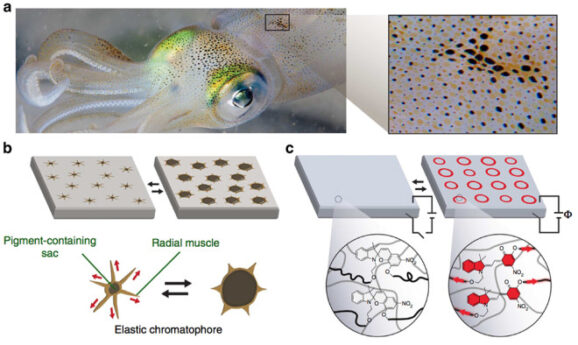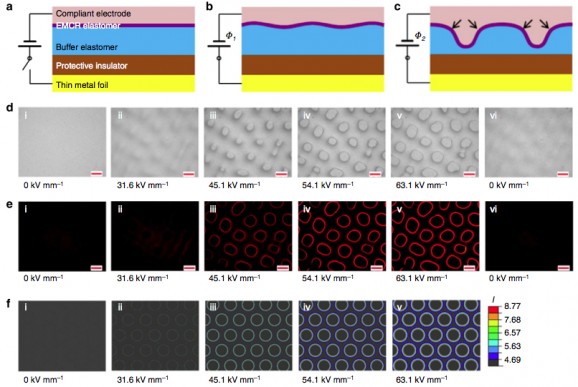New Material Can Change Color And Texture Like Octopi
This article is more than 2 years old
 Cephalopods (octopi, squid, and cuttlefish) are nature’s sneakiest animals, which is why scientists have long used them as a model for developing robots. Cephalopods have an uncanny ability to camouflage themselves, changing color, shape, and texture in a matter of seconds to hide from predators. A few years ago, DARPA developed a tethered robot that could change color, and now, a research team led by an MIT professor have developed a material that more closely emulates the cephalopod by changing color, luminosity, and texture.
Cephalopods (octopi, squid, and cuttlefish) are nature’s sneakiest animals, which is why scientists have long used them as a model for developing robots. Cephalopods have an uncanny ability to camouflage themselves, changing color, shape, and texture in a matter of seconds to hide from predators. A few years ago, DARPA developed a tethered robot that could change color, and now, a research team led by an MIT professor have developed a material that more closely emulates the cephalopod by changing color, luminosity, and texture.
The new material is an “electro-active elastomer,” which essentially means that it’s a flexible polymer that can be activated via electrical signals. The elastomer could be manufactured relatively easily, with already available materials. In experiments designed to test proof of concept, and published in Nature Communications, the research team was able to configure the synthetic material to change its texture and brightness, or its texture and color, in response to electrical pulses. The team embedded special molecules in the elastomer that mechanically respond to changes in voltage. And much like with cephalopods, when there’s no voltage being delivered, the elastomer essentially relaxes into its basic shape. Much like cephalopods, the material changes at the flip of a switch.
The most obvious application for this technology is militaristic. Combat fatigues and other military camouflage techniques are static — they work in the particular environment they were specifically designed for, but if a person or vehicle moves into another environment, they’re completely vulnerable. If camouflage could be produced with this elastomer, then it could change dynamically with the soldiers’ environment, ultimately saving lives and money.

The elastomer could also be used on ships, which over time become covered with barnacles and other microbes that diminish the ship’s speed and sometimes its maneuverability. Previous studies have shown that if the texture of a ship’s hull changes — presumably, from the usual smooth texture to a bumpier one, then the vast majority of that “fouling” could be removed and/or prevented.
The next step in the elastomer’s development is adding more patterns to increase the types of camouflage available. The colors available with the prototype are limited, but in the future, a slew of new colors could be added. Color me impressed by this stuff!











